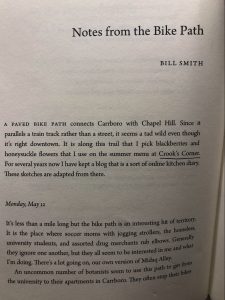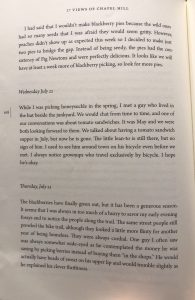Andie McKinnon
Contemporary Food Issues
Citation #2

Smith, Bill. “Notes from the Bike Path.” 27 Views of Chapel Hill, edited by Daniel Wallace, Eno Publishers, 2011, p. 104.

Smith, Bill. “Notes from the Bike Path.” 27 Views of Chapel Hill, edited by Daniel Wallace, Eno Publishers, 2011, p. 105.

Smith, Bill. “Notes from the Bike Path.” 27 Views of Chapel Hill, edited by Daniel Wallace, Eno Publishers, 2011, p. 107.

Smith, Bill. “Notes from the Bike Path.” 27 Views of Chapel Hill, edited by Daniel Wallace, Eno Publishers, 2011, p. 108.
My object is a chapter of compiled blog posts from Bill Smith’s blog “A Year in the Kitchen (and on the Road).” Bill smith is a chef of Crook’s Corner, one of Chapel Hill’s most famous restaurants. He is the author of Seasoned in the South, and has been a finalist twice for the James Beard Award for Best Chef in the Southeast. He is also the founder of Cat’s Cradle in Carrboro.
In this chapter, “Notes from the Bike Path,” Bill Smith describes his frequent foraging excursions along the paved bike path that connects Chapel Hill and Carrboro. This chapter illustrates the food Smith forages on the bike path for his restaurant, Crook’s Corner. Smith also illuminates the people he encounters on the bike path, more namely homeless individuals.
Smith paints a fairly romantic picture of foraging through honeysuckle and blackberry bushes on the bike path–he even composes his own unique spanish verb to describe his foraging. This phrase is “Voy a marianar [it] means I’m leaving to pick honeysuckle flowers and drink beer along the bike path” (105). He then proceeds to describe the wonderful varieties of honeysuckle found along the path, mentioning how he will use them in honeysuckle sorbet served in his restaurant. Next, describes late-summer blackberries. He says, “This is… my favorite Spanish word–morado, meaning purple, the color of blackberries. It comes up often in pop ballads because it is the color of the bruises that love can leave on the heart. My hands have been morado as well lately…” (107). Smith uses these blackberries to make desserts in his restaurant as well, such as blackberry pie, blackberry cobbler, and blackberries in sabayon.
For Bill Smith, this urban foraging is something of an artisanal activity. Smith finds beauty and simplicity in the ingredients he finds growing wild among the bike path, and his restaurant benefits from this foraging as a menu with text that emphasizes the wild, local origin of ingredients could likely be considered romantic and desirable by customers. However, to be able to consider the act of foraging a pleasurable or luxury activity is a form of privilege, as for many individuals, foraging is less of a romantic or leisurely activity and more of a necessity.
In addition to describing ingredient finds, Smith also gives short profiles of various homeless individuals he frequently interacts with on the bike path. Smith describes them as always cordial–“The same street people still prowled the bike trail, although they looked a little more flinty for another year of being homeless” (108). One sentence regarding the homeless population he encounters illustrates to the less glamorous aspect of urban foraging: “One guy I often saw was always somewhat wide-eyed as he contemplated the money he was saving by picking berries instead of buying them in the shops”(108). For this homeless individual, foraging for food is not seen as an artisanal activity at all, but rather as a mode of survival.
In conclusion, this chapter by Bill Smith highlights the role privilege holds in activities such as foraging. This piece matters to contemporary food issues, as local, “farm-to-table” food has been rising in popularity in recent years. This popular fad has created a space for an activity such as foraging to become romanticized, when for many individuals, it is anything but.
Works Cited
Smith, Bill. “Notes from the Bike Path.” 27 Views of Chapel Hill, edited by Daniel Wallace, Eno Publishers, 2011, pp. 104-109.